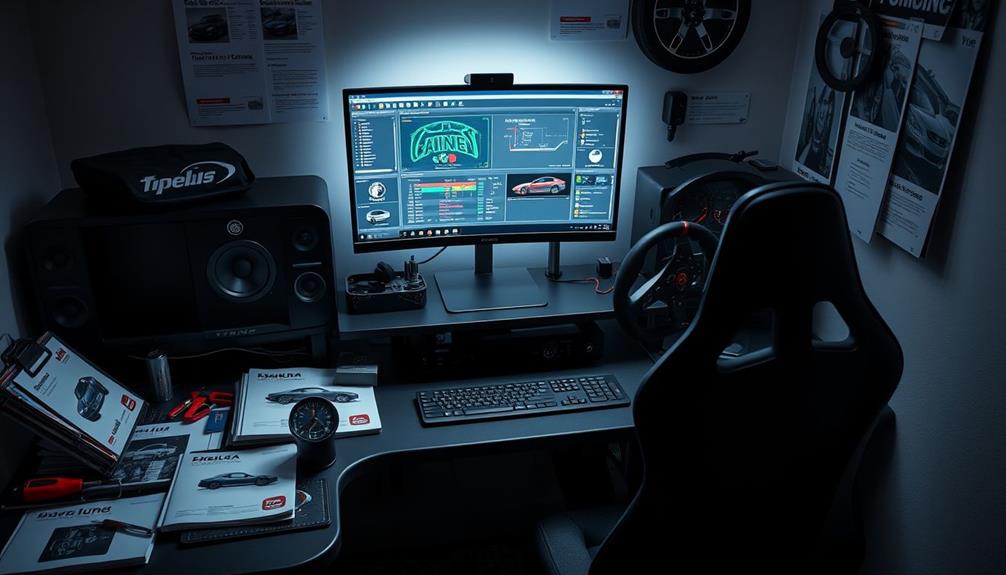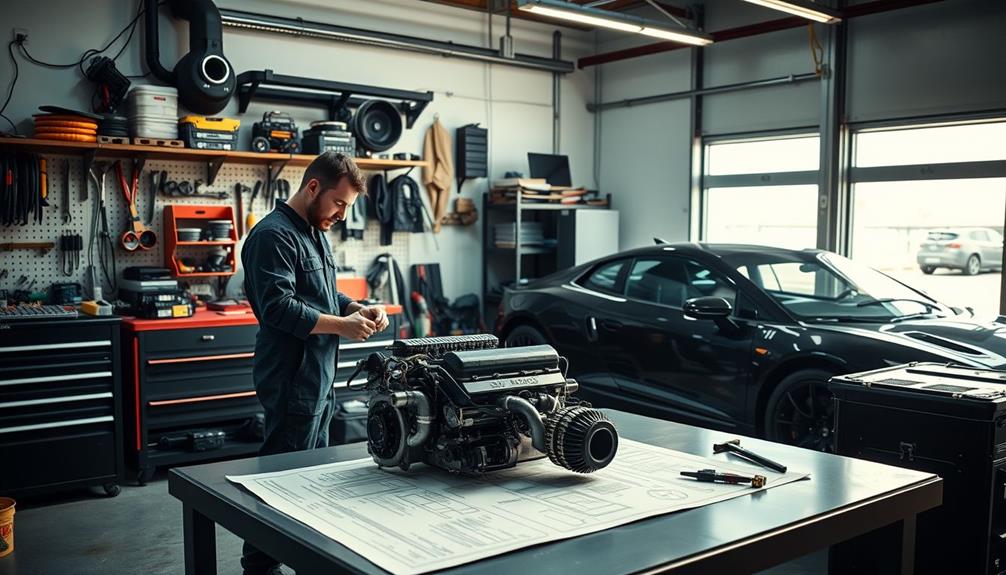Using car tuning software can release your vehicle's true performance. Start by selecting reliable software compatible with your make and model. Install the necessary drivers and set up your computer effectively. Connect the tuning software to your vehicle's ECU, ensuring a proper connection. Always back up the original settings before making adjustments. Focus on key parameters like the air-fuel ratio and ignition timing to enhance performance. Utilize a dynamometer for testing and feedback, allowing for precise adjustments. After each tweak, monitor performance closely to gauge improvements. There's much more to explore for achieving ideal results.
Key Takeaways
- Research and select compatible car tuning software that is user-friendly and reputable to avoid operational issues.
- Ensure your computer meets system requirements and install necessary drivers for the ECU tuning cable before proceeding.
- Connect to the ECU by powering the vehicle's ignition and following software prompts to establish a connection.
- Back up original ECU settings to a secure location to allow easy reversion to factory configurations if needed.
- Analyze performance metrics in real-time, adjusting air-fuel ratio and ignition timing to optimize engine performance effectively.
Overview of Car Tuning Software
Car tuning software is increasingly popular among automotive enthusiasts looking to enhance their vehicle's performance. With ECU tuning, you can modify engine settings without any physical alterations to your car. This software allows you to adjust key parameters such as air-fuel ratio (AFR) and ignition timing, which are vital for optimizing both power and fuel efficiency.
Many popular tuning software options come with step-by-step guides and support, making it accessible even for beginners to start tuning at home. Tools like the Integrated Engineering IE POWERlink cable enable you to reverse engineer factory mappings, allowing for personalized performance adjustments tailored to your preferences.
One of the best features of car tuning software is its ability to retain factory reliability after tuning. You can easily revert to stock settings whenever necessary, ensuring you won't compromise your vehicle's stability.
Selecting the Right Software

Finding the right car tuning software is vital for optimizing your vehicle's performance effectively. Start by researching reputable companies like Integrated Engineering to guarantee you're investing in quality and reliability.
Compatibility with your vehicle's make and model is fundamental; using software not designed for your control unit (ECU) can lead to operational issues and hinder your tuning efforts.
Next, look for software with a user-friendly interface and thorough guides. If you're new to car tuning, these resources will make the process smoother and less intimidating. Additionally, it’s important to find software that offers good customer support in case you encounter any technical issues or have questions about the car tuning process. Look for a program that provides forums or online communities where you can connect with other users and get advice on fine-tuning your vehicle. These resources can provide invaluable information and support as you navigate the car tuning process.
Real-time data logging features can greatly enhance your tuning experience, allowing for immediate adjustments to improve your vehicle's level of performance.
Don't forget to read user reviews and browse forums to gather insights from others who've used the software. Their experiences can provide valuable information about the software's effectiveness and whether it meets your specific tuning needs.
Setting Up Your Computer

Preparing your computer for car tuning is fundamental for a seamless experience. First, make certain your computer meets the minimum system requirements specified by your tuning software. This includes checking RAM, processor speed, and available storage space to guarantee smooth operation while you tune your car.
Next, download and install the necessary drivers for your ECU tuning cable. These drivers are imperative for enabling communication between your computer and the vehicle's ECU, which is essential for accurate tuning.
To optimize performance, close any unnecessary applications and processes running on your computer. This helps prevent potential software conflicts during the tuning process, allowing you to focus solely on enhancing your vehicle's performance.
Create a dedicated folder for your tuning software and related files. This organization will make it easier to access important documents like tuning maps and logs, particularly when making adjustments to your exhaust system.
Lastly, remember to regularly back up your original ECU settings and any custom tunes you create. Having these backups will allow you to revert to previous configurations if needed, guaranteeing you can always return to a baseline setup.
Connecting to the ECU

Before you can start tuning your vehicle, you'll need to connect to the ECU. First, make sure you have the necessary tuning software installed on your computer and a compatible interface cable, like the IE POWERlink cable from Integrated Engineering. This cable is critical for establishing a successful connection.
Next, turn on your vehicle's ignition without starting the combustion engine. This action powers the ECU and allows for communication. Once that's done, open your tuning software and select the appropriate vehicle model and ECU type to guarantee compatibility. This step is essential for effective tuning.
Follow the prompts in the software to initiate the connection. You may need to select options like "Connect" or "Read ECU" to establish communication with the ECU.
Once you're connected, you'll be able to read the existing ECU maps and parameters. This information is fundamental as it allows you to make informed adjustments for optimizing performance. With this connection established, you're one step closer to accessing your vehicle's potential through tuning.
Backing Up Original Settings

Before you start tuning your car, it's essential to back up the original ECU settings.
This step guarantees you can easily revert to the factory configuration if anything goes wrong.
Follow the backup process carefully to protect against any potential performance issues.
Importance of Backup
Backing up your original ECU settings is important for any car tuning process. If something goes wrong during tuning, you'll want the ability to restore your vehicle's performance to its factory state.
Here's why you should prioritize backing up your ECU settings:
- Reversibility: A backup allows you to revert to the original configuration if the tuning leads to undesirable performance or issues. You can make adjustments confidently, knowing you can always go back.
- Warranty Protection: Maintaining a backup is essential for preserving your vehicle's warranty. Many manufacturers require that modifications be reversible, or you risk voiding your coverage.
- Data Security: The backup process typically involves saving your ECU file to a computer or USB drive. This safeguards against potential data corruption or loss during tuning, especially if you're adding components like a cold air intake.
Before tuning, make certain you have your original settings backed up.
Regularly updating this backup guarantees you have the most recent factory settings, particularly if your ECU has undergone updates.
Protect your investment and performance by prioritizing this critical step!
Backup Process Steps
Creating a backup of your original ECU settings is a straightforward process that sets the stage for successful car tuning.
First, connect your vehicle to the tuning software using an OBD-II interface or a compatible cable. This connection is vital for transferring data safely.
Once you've established the connection, follow the software prompts to initiate the backup. This usually involves reading the current ECU map and saving it to your computer or another designated storage device.
Make sure you pay attention during this step; a stable connection is essential to guarantee a complete backup.
After the backup process is complete, verify the integrity of the backup file. Check its size and format to confirm it aligns with the expected parameters set by the tuning software.
This will help you avoid issues when restoring your settings later.
Analyzing Performance Metrics

When you're tuning your car, understanding key performance indicators like horsepower and torque is essential for gauging your engine's efficiency.
You'll want to monitor real-time data to see how your adjustments affect performance. Keeping a close eye on these metrics helps you optimize your tuning for the best results.
Key Performance Indicators
To effectively improve your vehicle's performance, understanding Key Performance Indicators (KPIs) is important. These metrics help you assess the effectiveness of your tuning modifications and guarantee that your car runs at its best.
Here are three key KPIs you should focus on:
- Horsepower and Torque: Monitor your vehicle's horsepower and torque curves. They provide insights into engine performance across various RPMs, allowing you to identify peak power and ideal shift points.
- Air-Fuel Ratio (AFR): The ideal AFR for performance is around 12.5:1. Deviations from this can lead to power loss or even engine damage, so keeping a close eye on this metric is essential.
- Boost Pressure: For turbocharged and supercharged engines, boost pressure levels are important. Adjusting these levels can greatly enhance acceleration and responsiveness, making it a critical KPI to track.
Monitoring Real-Time Data
Monitoring real-time data is a game-changer for anyone tuning a car. By keeping an eye on critical performance metrics like air-fuel ratio (AFR), boost pressure, and ignition timing while the engine runs, you gain valuable insights into how your tuning adjustments affect performance.
Using ECU tuning software, you can access live data streams from various sensors, such as mass air flow and throttle position, which enables you to fine-tune the engine based on real driving conditions.
As you analyze these performance metrics in real-time, you can quickly identify potential issues like knocking or detonation. This allows you to make immediate adjustments to ignition timing and fuel delivery, protecting your engine from damage.
Many tuning software packages provide graphical representations of the data, making it easier to track trends and performance changes during different driving scenarios.
Regularly monitoring real-time data during your tuning sessions leads to informed decisions that enhance engine efficiency. This process ultimately results in higher horsepower and torque outputs, making your tuning efforts more effective and rewarding.
Making Adjustments for Performance

Accessing your ECU tuning software is the first step in making effective adjustments for performance. Start by loading your vehicle's existing map to analyze the current settings.
Once you've familiarized yourself with the data, focus on these key adjustments:
- Adjust the Air-Fuel Ratio (AFR): Set it to around 12.5 for ideal power output, while ensuring the mixture stays within safe limits to prevent engine damage.
- Modify Ignition Timing: Advance the timing to 2 degrees past top dead center (TDC) for maximum combustion efficiency. You may need to adjust this based on engine load and speed.
- Save Tuning Profiles: Regularly save different tuning profiles to revert to previous settings easily and track performance changes over time.
After making these adjustments, monitor your vehicle's performance closely. Each tweak can greatly impact how your car runs, so be cautious and fine-tune as necessary.
These steps will help you access your vehicle's potential while ensuring safe and effective performance enhancements.
Using a Dyno for Feedback

Using a dyno is essential for getting accurate feedback on your car's performance during tuning.
It helps you understand how your modifications impact horsepower and torque, allowing you to make informed adjustments.
Dyno Testing Basics
When you immerse yourself in dyno testing, you enter a controlled environment that lets you measure your vehicle's power output at the wheels. This setup is essential for understanding how modifications and tuning adjustments impact performance.
You'll typically use one of two types of dynos: the chassis dynamometer, which measures power at the wheels, or the engine dynamometer, which assesses power directly from the engine.
Here are three key aspects to keep in mind during dyno testing:
- Data Monitoring: You can track real-time metrics like horsepower, torque, air-fuel ratio (AFR), and ignition timing. This data is significant for making precise tuning adjustments.
- Multiple Runs: Conducting several runs helps guarantee consistent results. Be aware that variables like temperature, humidity, and vehicle condition can affect power readings.
- Identifying Issues: Dyno testing can reveal potential problems, such as fuel delivery issues or ignition timing inaccuracies, giving you valuable feedback for optimizations.
Interpreting Dyno Results
After completing your dyno testing, it's time to interpret the results to understand how your tuning adjustments have impacted performance.
The dyno provides vital data on horsepower and torque curves, helping you identify peak performance points and areas that need further tuning. The graph displays both power and torque outputs as functions of engine RPM, allowing you to visualize how your changes affect performance at different speeds.
Pay close attention to the air-fuel ratio (AFR) during the runs. Maintaining an ideal AFR is essential for maximizing power while ensuring your engine remains safe and efficient.
A well-executed dyno session also allows you to make real-time adjustments to ignition timing and boost levels, directly correlating these changes to the performance metrics you observe.
Testing Your Vehicle

How can you guarantee your vehicle is ready for tuning? The key is thorough testing before diving into any adjustments.
Start by conducting a baseline test using a dynamometer to establish your vehicle's current performance metrics, like horsepower and torque levels. This gives you a clear reference point for future comparisons.
Here are three essential steps to follow:
- Monitor Engine Parameters: Record key metrics such as air-fuel ratio (AFR), ignition timing, and boost pressure during your initial testing. This helps pinpoint areas needing improvement later.
- Conduct Acceleration Tests: Perform a series of controlled acceleration tests to gauge your vehicle's performance. This guarantees you have a solid understanding of how it currently performs.
- Utilize OBD-II Tools: Use OBD-II diagnostic tools to retrieve fault codes and monitor real-time data from engine sensors. This step guarantees your vehicle is in peak condition before any tuning modifications.
Once you've completed these tests, you'll be well-prepared to use your car tuning software effectively.
Fine-Tuning and Optimization

With your vehicle tested and performance metrics established, you're ready to focus on fine-tuning and enhancement. This stage is essential for maximizing performance. Start by understanding the air-fuel ratio (AFR); ideally, it should be around 12.5:1, but this may vary based on engine modifications and load conditions.
Next, adjust the ignition timing, aiming for about 2 degrees past top dead center (TDC). This helps achieve maximum cylinder pressure while avoiding detonation. Utilizing dyno tuning is highly beneficial here, as it allows precise adjustments across various RPMs, helping you analyze and enhance parameters like boost pressure, AFR, and ignition timing effectively.
Here's a quick reference table for key tuning parameters:
| Parameter | Ideal Value |
|---|---|
| Air-Fuel Ratio (AFR) | ~12.5:1 |
| Ignition Timing | ~2° past TDC |
| Boost Pressure | Varies by application |
| RPM Range | 2000-7000 RPM |
| Tuning Software | Access to advanced maps |
Regular adjustments and monitoring are essential, as environmental conditions and driving styles can greatly impact engine behavior and efficiency. Stay vigilant for ideal performance!
Frequently Asked Questions
How Does Car Tuning Software Work?
Car tuning software works by connecting to your vehicle's ECU, reading engine parameters, and allowing you to modify settings like air-fuel ratios and ignition timing. It optimizes performance based on sensor data and your goals.
How to Tune an Engine for Performance?
Ready to release your engine's potential? Start by analyzing the air-fuel ratio, tweak ignition timing, and use dyno tuning for real-time adjustments. Don't forget to monitor changes to maximize performance and avoid overheating!
Can I Tune My ECU Myself?
Yes, you can tune your ECU yourself using specialized software. Just make certain you understand your car's current performance metrics, research reputable tools, and be aware of any legal or warranty issues before making adjustments.
What Are the Stages of Car Tuning?
When you think about car tuning, imagine transforming your ride's performance. You start with an ECU remap, then progress through intermediate tweaks, dyno adjustments, and finally, custom settings for a uniquely exhilarating driving experience.
Conclusion
Now that you've navigated the ins and outs of car tuning software, you're on the brink of revealing your vehicle's true potential. But wait—before you hit the road, remember that fine-tuning is key. Every adjustment can lead to thrilling performance or unexpected surprises. Will you release a beast on the asphalt, or will you find yourself in a tricky situation? Only time—and your careful tuning—will tell. Buckle up; the journey's just beginning!










